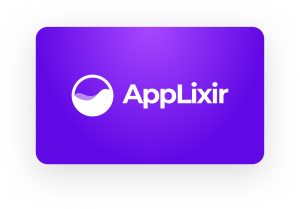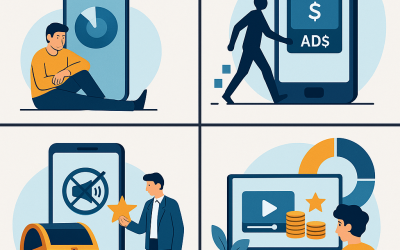What Actually Makes Users Click “Watch”? The Psychology Behind Rewarded Ads
In the evolving landscape of mobile app monetization strategies, rewarded ads have emerged as a game-changer. Unlike traditional advertising formats that interrupt the user experience, rewarded ads create a unique value exchange: users voluntarily watch an advertisement in return for in-app benefits like extra lives, virtual currency, or premium content. This win-win approach has proven effective for both developers seeking sustainable revenue and users wanting to enhance their app experience without opening their wallets.
But here’s the million-dollar question: What truly motivates users to click that “Watch” button? Understanding the psychological drivers behind this decision can transform how you implement incentivized ads and dramatically improve your monetization results.
Contents
- 1 What Are Rewarded Ads and Why They Work
- 2 The Psychology of Choice: Giving Users Control
- 3 Instant Gratification & Reward Systems
- 4 The Perceived Value of Rewards
- 5 Timing Is Everything: When to Show the Ad
- 6 Trust, Transparency, and User Experience
- 7 Data-Driven Optimization: What Keeps Users Clicking?
- 8 AppLixir: Building Smarter, User-Centric Ad Strategies
What Are Rewarded Ads and Why They Work
Rewarded ads are a type of incentivized ads that offer users tangible in-app rewards in exchange for engaging with advertising content, typically video ads lasting 15-30 seconds. Unlike interstitial ads that appear between app sessions or banner ads that occupy screen real estate, rewarded ads are entirely opt-in. Users actively choose to watch them, knowing exactly what they’ll receive in return.
This fundamental difference makes rewarded ads far less intrusive and significantly more effective. They fit naturally into mobile app monetization strategies because they respect user agency while still generating revenue. Studies consistently show that rewarded ads achieve higher completion rates and better user sentiment compared to forced ad formats, making them an essential tool for developers who want to monetize without sacrificing user retention.
The Psychology of Choice: Giving Users Control
The power of rewarded ads lies in a simple but profound psychological principle: voluntary participation. When users choose to watch an ad rather than being forced into it, they experience a sense of autonomy that fundamentally changes their relationship with the advertising content.
This concept aligns with self-determination theory, which posits that autonomy—the feeling of being in control of one’s choices—is a basic human need that drives motivation and engagement. In the context of incentivized ads, users aren’t victims of interruption; they’re active participants making strategic decisions about their app experience. This psychological shift transforms ads from annoying obstacles into valuable tools, dramatically increasing engagement rates and reducing negative sentiment. Smart mobile app monetization strategies leverage this principle by always making rewarded ads optional and clearly communicating the value exchange upfront.
Instant Gratification & Reward Systems
One of the most powerful psychological mechanisms driving rewarded ad engagement is the promise of instant gratification. When users watch an ad and immediately receive coins, power-ups, extra lives, or unlocked content, their brain releases dopamine—the neurotransmitter associated with pleasure and reward. This creates a positive association between watching ads and feeling good.
This isn’t accidental; it’s the same psychological principle that makes games addictive and social media compelling. Users quickly learn that clicking “Watch” leads to immediate benefits, establishing a behavioral pattern through positive reinforcement. The reward isn’t abstract or delayed—it happens instantly, satisfying our brain’s preference for immediate payoffs over distant promises.
Interestingly, the psychology becomes even more powerful when rewards vary slightly or offer surprise bonuses. This variable reward structure, similar to slot machines or loot boxes, keeps users engaged because they never know if this particular ad might offer something extra special. For developers implementing mobile app monetization strategies, this means rewarded ads aren’t just revenue generators—they’re engagement tools that keep users active and invested. The key is ensuring that the reward always feels worth the 30 seconds of attention, maintaining that positive reinforcement loop.
The Perceived Value of Rewards
Not all rewards are created equal in the user’s mind. The likelihood of clicking “Watch” depends heavily on the perceived value of what’s being offered. A casual player might happily watch an ad for cosmetic items or minor currency boosts, while a hardcore gamer will only engage with rewarded ads that offer strategically significant benefits—an extra life during a particularly challenging level, a rare power-up, or premium currency that would otherwise cost real money.
Context matters enormously here. The same reward that feels trivial during easy gameplay becomes irresistible when a user is stuck on a difficult challenge. This is why player segmentation is crucial for effective mobile app monetization strategies. Understanding your user base—their play patterns, their pain points, and what they value most—allows you to tailor reward offerings that maximize engagement. A well-designed rewarded ads system offers different incentives for different player types and adjusts value based on where users are in their app journey.
Timing Is Everything: When to Show the Ad
Even the most valuable reward won’t drive engagement if the ad appears at the wrong moment. Timing and placement dramatically impact click-through rates and user satisfaction. The golden rule: show rewarded ads when users are most receptive and least disrupted.
The best moments typically come at natural breakpoints—after completing a level, when users have just lost a game and want to continue, or before attempting a particularly challenging task they know they’ll need help with. These moments align with user motivation, making the ad feel like a helpful option rather than an interruption. Conversely, showing ads mid-action or during intense gameplay creates frustration and damages the user experience, even if the ad is optional.
Successful mobile app monetization strategies respect user flow and game progression. They position rewarded ads as strategic choices that enhance rather than disrupt the experience. This approach not only increases engagement with individual ads but also builds long-term user trust and retention.
Trust, Transparency, and User Experience
Users are far more likely to engage with rewarded ads when the value exchange is crystal clear and consistently delivered. Transparency builds trust, and trust drives sustained engagement. A simple, honest message like “Watch this 30-second video to earn 50 coins” sets clear expectations that, when met, reinforce positive user sentiment.
The opposite—unclear terms, rewards that don’t deliver, or bait-and-switch tactics—destroys trust faster than any other monetization misstep. If users click “Watch” and the ad fails to load, takes too long, or doesn’t deliver the promised reward, they’ll be hesitant to engage again. Even worse, these negative experiences can drive app abandonment entirely.
Successful incentivized ads prioritize user experience alongside revenue generation. This means ensuring ads load quickly, work reliably across devices, and always deliver exactly what was promised. Good UX combined with transparent incentivization doesn’t just improve individual ad performance—it creates a positive monetization environment where users feel respected and valued, leading to better long-term retention and revenue.
Data-Driven Optimization: What Keeps Users Clicking?
Understanding psychology provides the foundation, but data-driven optimization turns that understanding into results. The most successful mobile app monetization strategies continuously test and refine their rewarded ads implementation based on real user behavior.
A/B testing is essential here. Experiment with different reward values to find the sweet spot between generous enough to motivate and sustainable for your app economy. Test placement options to discover when users are most receptive. Try different ad lengths and formats to optimize completion rates. Track key metrics like click-through rate, completion rate, retention impact, and revenue per user to understand what’s actually working.
User segmentation takes this further by recognizing that different players respond to different incentives. New users might need smaller, more frequent rewards to build engagement habits, while veteran players might prefer larger, rarer rewards that feel more valuable. Geographic, demographic, and behavioral data can all inform how you present rewarded ads and incentivized ads to maximize both user satisfaction and revenue generation.
AppLixir: Building Smarter, User-Centric Ad Strategies
Users click “Watch” because they feel in control of the decision, they see clear value in the reward, and they receive instant gratification. These psychological principles—autonomy, perceived value, immediate reinforcement, and trust—are the foundation of effective rewarded ads implementation.
The most successful mobile app monetization strategies don’t treat ads as necessary evils to be tolerated. Instead, they recognize that well-designed rewarded ads enhance the user experience by providing meaningful choices and valuable rewards. By applying these psychological insights and continuously optimizing based on data, you can create advertising experiences that users genuinely appreciate—and that reliably generate revenue.
Ready to refine your monetization approach? Start by examining your current rewarded ads implementation through the lens of user psychology, and watch your engagement rates climb.


